England's beautiful southern coast plus the Isle of Wight
by June Griffin, Lewiston, ME
England’s southern coast along the channel, especially East and West Sussex, is a beautiful place to visit. In May ’06 I had a wonderful stay there in beautiful weather. The temperature was in the 70s, and from London south people were enjoying sunshine and no rain. While the newspapers reported a heat wave when upper 70s were recorded, a real heat wave did develop later in the summer in England and all over Europe.
I knew this area of England from previous visits, so I was able to plan a “customized visit” for my travel companion, Sally Maguire, and myself. We planned to make the town of Arundel in West Sussex a base for exploring the surrounding area, including places like Chichester, Brighton, the Petworth House and the Isle of Wight. We arranged a 7-night stay at a hotel in Arundel and would end our trip with three days in London before flying home.
Home base
We each flew to Heathrow on British Airways, Sally from Denver and I from Boston’s Logan Airport. We had made arrangements to be picked up at the airport by Central Chauffeur Services (phone 888/556-8616, www.centralchauffeur.com), recommended to Sally by a friend. Based in the United Kingdom, they offer airport transfers and distance travel. (Bookings must be made in advance, and you have to pay by credit card.)
We paid £119 ($237) for transport from Heathrow to our hotel in Arundel — so much easier than traveling with luggage by taxi and train, which I have done. We were picked up right on time in a luxurious car and driven about two hours to Arundel over country roads.
We had reserved two rooms for seven nights at The Town House hotel (65 High St.; www.thetownhouse.co.uk) in Arundel, a hilltop town on the Arun River which is dominated by a great castle, home of the Duke of Norfolk for more than 850 years.
Arundel has narrow side streets and a steep hill lined with tearooms, shops and galleries. Our small hotel was right across the street from the castle walls.
A restored Regency building, the Town House has five elegant rooms and an excellent restaurant. The building dates from the 1800s, and my large room had a 4-poster bed, a marble fireplace and floor-length windows.
For our week-long stay we took advantage of a rate special, which was £160 ($319) a night for two rooms, including breakfast — a real bargain.
We enjoyed just walking around Arundel and took a delightful hour-long ride with Arun River Cruises in an open boat. Views from the river were of the Duke’s castle and, on the horizon, another castle, Amberley Castle, over 900 years old and now a hotel.
Arundel Castle and its chapel and gardens are open to visitors from April to October. The elaborate rooms and art collection of the Dukes of Norfolk also contain memories of Mary Queen of Scots, who stayed there before being taken to London to be executed. The rosary beads she carried to her death are on display in the castle.
Arundel also has a 60-acre wildlife and wetland center and park with some of the best wild fowl viewing in the world.
Day-tripping
From Arundel we planned to spend a day in the cathedral town of Chichester, just 10 miles west. There were no bus tours available so we hired a taxi for the short ride over country roads.
The Old City walls follow the streets to the city center, which is marked by a stone tower topped by a cross — a place where everyone stops to take a picture. Next to the tower is the Norman cathedral, begun in 1076 and built on Roman foundations. We spent time there admiring the interior, especially the stained-glass window designed by artist Marc Chagall.
We walked the pedestrian streets of the town center and had a cream tea at a small café, enjoying this famous treat of scones with strawberry jam and clotted cream and a pot of tea.
The most famous place on the southern coast of England is the city of Brighton, which I had often visited but which was new to Sally. We again hired a taxi to drive us the 20 miles or so on a day of unusually warm, sunny weather.
What was once a tiny fishing village is now a shore lined with huge hotels on the promenade facing the sea. This growth started when sea bathing became a healthy attraction in the 18th century. The Prince Regent, who later became King George IV of England, came to Brighton in 1783, followed by masses of people. Perhaps the most remarkable building in all of Britain is its fairy-tale Royal Pavilion, built by the Prince Regent to reflect his taste for exotic Eastern design. The domed, pinnacled roof is a startling sight.
When Queen Victoria came to the throne, she disapproved of the showy palace and wanted to demolish it, but the local council bought it and today the palace looks much as it did originally. It is visited by over 320,000 visitors a year.
Besides visiting the dazzling palace with its lovely gardens, almost every visitor wants to walk the famous Brighton Lanes, a pedestrian maze of narrow alleys and squares. Although the area has changed in recent years, its antique shops now high-priced jewelry stores, there are still restaurants and cafés where one can enjoy tea and shortbread. A new attraction is the North Laine area, which has a flea market and shops more like those of the original Lanes.
Brighton’s famous pier has rides and entertainment, and you can see the remains of the old pier on the shore front. Plans are being made for its restoration.
Just 12 miles north of Arundel is Petworth House, a popular attraction. Built in the late 1600s, it is still the home of Lord and Lady Egremont and is set in a 700-acre deer park.
The family art collection is spectacular, with many works by Turner. There is a huge room that was built just to display the sculpture and paintings the family has collected. Owned by the National Trust, the home is open for tours from March through October.
Isle of Wight
We did take a day trip to the Isle of Wight, which I had always wanted to visit. Located just off the southern coast across the Solent Channel, the triangle-shaped island has a coastal stretch of about 60 miles that varies from sandy beaches to ravines and rock formations with cliffs of many colors. Offshore sit the famous Needles, three huge chalk pillars jutting from the sea.
Visitors arrive on the Isle of Wight as we did, at Ryde. We took a train from Arundel station, a short taxi ride from our hotel, to Portsmouth, then a large car ferry across the Solent to the island. Ryde has a park and gardens at the shore plus many shops and restaurants.
We took a sightseeing ride with commentary on the Vagus Road Train, a bright-orange open-sided train, which made for a very pleasant hour-long trip along the coast.
We did not get to see all the small towns, harbors and tourist attractions on the Isle of Wight on our one-day visit, but we did find several unique museums worth a visit. The Museum of Geology houses the many fossils found on the island, including traces of dinosaurs, and the Smuggling Museum covers the history of smuggling over the last 700 years.
The Isle of Wight was made famous by Queen Victoria, who built a house there. Osborne House, which is open to the public most days of the year, was designed by Prince Albert in the style of an Italian villa, and the Queen spent happy years there with her children. A special playhouse for the children, Swiss Cottage, now contains the Queen’s collection of porcelain.
On to London
Three days in London ended my springtime visit to England. I spent time at the British Museum, seeing the wonderful Elgin Marbles again, and visited the National Gallery to see a show of American artists who worked in Paris from 1860 to 1900.
We stayed at a small, elegant hotel in London, The Leonard (15 Seymour St.; phone +44 207 935 2010, www.theleonard.com). Located near the Marble Arch, the hotel is made up of four 18th-century townhouses. Current room rates start at around £150 ($299) per night; special promotions are available online.
We made time for a real British dinner at Simpsons, The Savoy’s famous restaurant where the waiters serve you from silver-domed trolleys. Entrées start at around £17 ($34).
A 2-hour tour on a traditional sightseeing bus renewed our views of famous attractions and completed our visit to the city and country.




